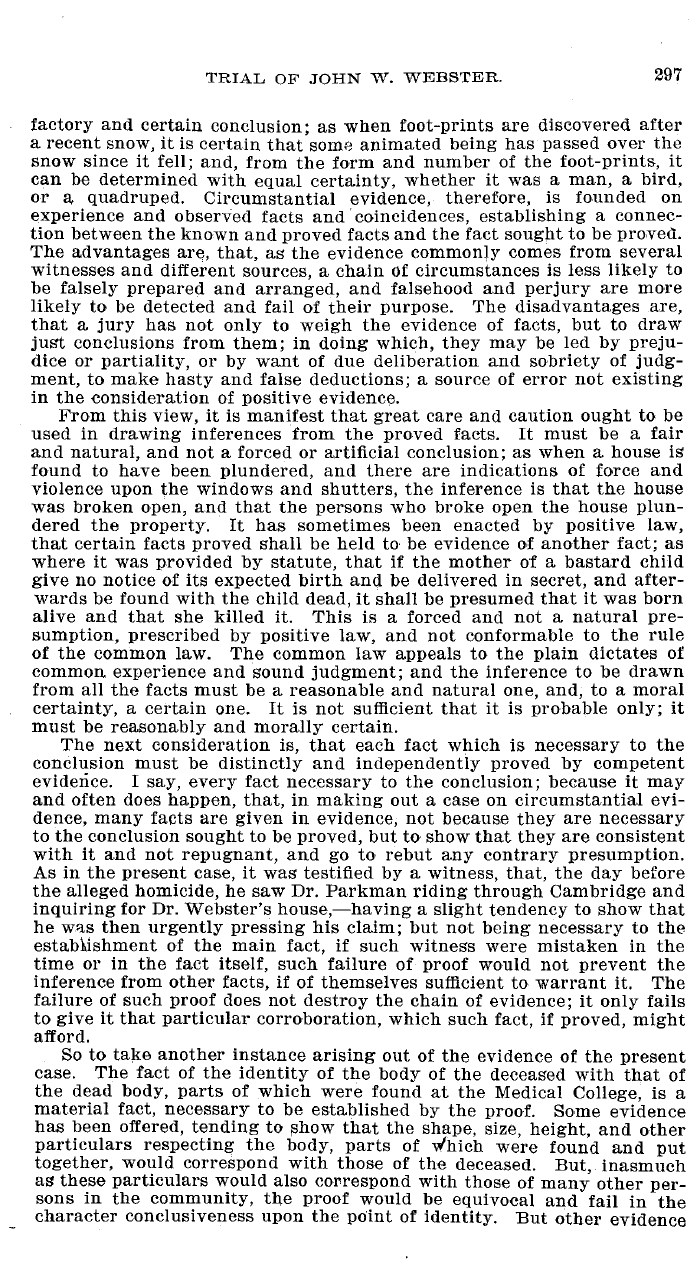|
TRIAL OF JOHN W. WEBSTER. 297
factory and certain conclusion; as when foot-prints are discovered after
a recent snow, it is certain that some animated being has passed over the
snow since it fell; and, from the form and number of the foot-prints, it
can be determined with equal certainty, whether it was a man, a bird,
or a quadruped. Circumstantial evidence, therefore, is founded on
experience and observed facts and coincidences, establishing a connec-
tion between the known and proved facts and the fact sought to be proved.
The advantages are, that, as the evidence commonly comes from several
witnesses and different sources, a chain of circumstances is less likely to
be falsely prepared and arranged, and falsehood and perjury are more
likely to be detected and fail of their purpose. The disadvantages are,
that a jury has not only to weigh the evidence of facts, but to draw
just conclusions from them; in doing which, they may be led by preju-
dice or partiality, or by want of due deliberation and sobriety of judg-
ment, to make hasty and false deductions; a source of error not existing
in the consideration of positive evidence.
From this view, it is manifest that great care and caution ought to be
used in drawing inferences from the proved facts. It must be a fair
and natural, and not a forced or artificial conclusion; as when a house is
found to have been plundered, and there are indications of force and
violence upon the windows and shutters, the inference is that the house
was broken open, and that the persons who broke open the house plun-
dered the property. It has sometimes been enacted by positive law,
that certain facts proved shall be held to be evidence of another fact; as
where it was provided by statute, that if the mother of a bastard child
give no notice of its expected birth and be delivered in secret, and after-
wards be found with the child dead, it shall be presumed that it was born
alive and that she killed it. This is a forced and not a natural pre-
sumption, prescribed by positive law, and not conformable to the rule
of the common law. The common law appeals to the plain dictates of
common experience and sound judgment; and the inference to be drawn
from all the facts must be a reasonable and natural one, and, to a moral
certainty, a certain one. It is not sufficient that it is probable only; it
must be reasonably and morally certain.
The next consideration is, that each fact which is necessary to the
conclusion must be distinctly and independently proved by competent
evidence. I say, every fact necessary to the conclusion; because it may
and often does happen, that, in making out a case on circumstantial evi-
dence, many facts are given in evidence, not because they are necessary
to the conclusion sought to be proved, but to show that they are consistent
with it and not repugnant, and go to rebut any contrary presumption.
As in the present case, it was testified by a witness, that, the day before
the alleged homicide, he saw Dr. Parkman riding through Cambridge and
inquiring for Dr. Webster's house,-having a slight tendency to show that
he was then urgently pressing his claim; but not being necessary to the
estabbishment of the main fact, if such witness were mistaken in the
time or in the fact itself, such failure of proof would not prevent the
inference from other facts, if of themselves sufficient to warrant it. The
failure of such proof does not destroy the chain of evidence; it only fails
to give it that particular corroboration, which such fact, if proved, might
afford.
So to take another instance arising out of the evidence of the present
case. The fact of the identity of the body of the deceased with that of
the dead body, parts of which were found at the Medical College, is a
material fact, necessary to be established by the proof. Some evidence
has been offered, tending to show that the shape size, height, and other
particulars respecting the body, parts of dhich were found and put
together, would correspond with those of the deceased. But, inasmuch
as these particulars would also correspond with those of many other per-
sons in the community, the proof would be equivocal and fail in the
character conclusiveness upon the point of identity. But other evidence
|

